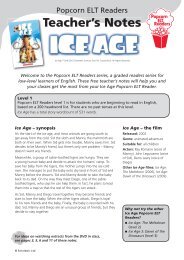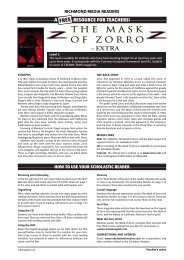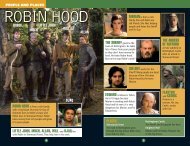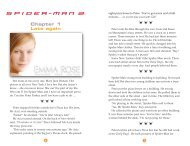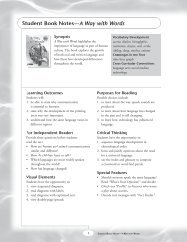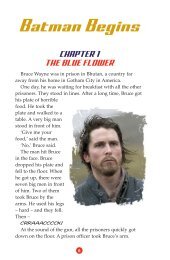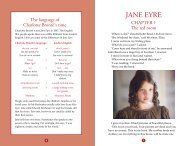Teacher's Notes - Richmond
Teacher's Notes - Richmond
Teacher's Notes - Richmond
You also want an ePaper? Increase the reach of your titles
YUMPU automatically turns print PDFs into web optimized ePapers that Google loves.
Popcorn ELT Readers<br />
Teacher’s <strong>Notes</strong><br />
Ice Age: The Meltdown TM & © 2010 Twentieth Century Fox Film Corporation. All Rights Reserved.<br />
Welcome to the Popcorn ELT Readers series, a graded readers series for<br />
low-level learners of English. These free teacher’s notes will help you and your<br />
classes get the most from your Ice Age: The Meltdown Popcorn ELT Reader.<br />
Level 2<br />
Popcorn ELT Readers level 2 is for students who are gaining confidence in reading in<br />
English, based on a 250 headword list. The simple past tense is introduced at this level.<br />
Ice Age: The Meltdown has a total story wordcount of 829 words.<br />
Ice Age: The Meltdown – synopsis<br />
In the valley where Manny the mammoth and his friends live, the<br />
weather is getting warmer. The ice is melting and a high wall of ice is<br />
holding back a huge lake of water, which will soon flood the valley.<br />
The animals’ only hope of survival is to reach the boat at the far end<br />
of the valley.<br />
Manny travels with his friends Sid the sloth and Diego the sabretoothed<br />
tiger. It is a long time since anyone has seen other<br />
mammoths in the valley, and Manny is starting to think that he is<br />
the last of his species. Then, suddenly, he meets a girl mammoth,<br />
Ellie. There’s only one problem – she thinks she’s a possum! Ellie is<br />
an orphan and grew up with a possum family. She has two possum<br />
brothers, Crash and Eddie. It’s clear to Sid and Diego that Manny and<br />
Ellie are meant to be together. Ellie finally accepts that she’s really a<br />
mammoth, but she has mixed feelings for Manny.<br />
The animals survive sea monsters, falling rocks and a flood of<br />
meltwater when the wall of ice falls. Finally the meltwater leaves the<br />
valley and a big herd of mammoths arrives. Ellie is going to join the<br />
other mammoths, but finally Manny tells her how he feels about her<br />
and she happily agrees to stay with him and his friends.<br />
For ideas on watching extracts from the DVD in class,<br />
see pages 3, 5, 6 and 12 of these notes.<br />
Ice Age: The<br />
Meltdown – the film<br />
Released: 2006<br />
Also known as: Ice Age 2<br />
Genre: animated adventure<br />
Suitable for: all children<br />
Actors: Ray Romano (voice of<br />
Manny), John Leguizamo (voice<br />
of Sid), Denis Leary (voice of<br />
Diego), Queen Latifah (voice of<br />
Ellie)<br />
Other Ice Age films: Ice Age<br />
(2002), Ice Age 3: Dawn of the<br />
Dinosaurs (2009)<br />
Why not try the other<br />
Ice Age Popcorn ELT<br />
Readers?<br />
● Ice Age (level 1)<br />
● Ice Age 3: Dawn of the<br />
Dinosaurs (level 3)<br />
© Scholastic Ltd
Popcorn ELT Readers<br />
Teacher’s <strong>Notes</strong><br />
Popcorn ELT Readers<br />
Teacher’s <strong>Notes</strong><br />
Contents<br />
Just choose the pages that you need and print!<br />
Meet … the animals from Ice Age (T) page 3<br />
New Words (T) page 4<br />
Using the story with your class (T) pages 5–6<br />
Chapter Quizzes (S) page 7–8<br />
Real World (T) page 9<br />
Real World Project: My Extinct Mammal (S) page 10<br />
Answer Key (T) page 11<br />
Imagine … / Chant (T) page 12<br />
New Words Flashcards pages 13–18<br />
(T) Teacher’s notes<br />
(S) Student activities (photocopiable)<br />
© Scholastic Ltd
Popcorn ELT Readers<br />
Teacher’s <strong>Notes</strong><br />
Meet … the animals<br />
from Ice Age<br />
The ‘Meet …’ page<br />
introduces students to the<br />
main characters in the story.<br />
This page is recorded on the CD.<br />
1 Ask (in L1) if anyone has read the first Ice Age<br />
Popcorn ELT Reader or seen the first film. If so,<br />
ask them to tell the class briefly what happened<br />
in the story.<br />
2 Look together at the front cover of the book.<br />
Ask How many animals can you see? (Six)<br />
Which animals are happy? Which animals are<br />
frightened? Students point to the animals. Why<br />
are they frightened? Listen to students’ ideas.<br />
OR<br />
Tell students that they’re going to see part<br />
of a film about animals from the ice age.<br />
Write up these questions: What are the animals<br />
doing? Are they happy? Why? Show the scene<br />
near the start of the film with the animals<br />
playing on the water slides (DVD scene 1).<br />
Students watch and think about the answers.<br />
Afterwards, discuss the answers with the class.<br />
Then ask (in L1) what problem the animals<br />
might have in the story. Students tell you what<br />
they think.<br />
3 Look at the ‘Meet …’ page with your class and<br />
ask some questions about the characters in the<br />
pictures, e.g. What colour are Crash and Eddie?<br />
Who has got long teeth? Is it hot or cold?<br />
4 Pre-teach valley and check pronunciation of<br />
sabre /’seiba/.<br />
5 T<br />
1<br />
Read the page out loud to the class or<br />
play the CD.<br />
6 Students close their books. Play a game of Who<br />
Am I? For example, say I love talking. Students<br />
say You’re Sid. Continue with information<br />
about the other characters. With stronger<br />
classes, ask students to take over your role.<br />
7 Read the ‘Before you read’ question with your<br />
class. Ask any students who haven’t seen the<br />
film to predict the answers. Say each<br />
character’s name and students call out friend<br />
if they think that character is going to be<br />
Manny’s friend at the end of the story.<br />
© Scholastic Ltd<br />
3
Popcorn ELT Readers<br />
Teacher’s <strong>Notes</strong><br />
New Words<br />
This page is recorded on the CD.<br />
The words on this page are available as<br />
flashcards, see pages 13–18 of these notes.<br />
The ‘New Words’ page presents up to<br />
ten new words that are included in the<br />
story, but are not on the headword list.<br />
There is usually a piece of conversational<br />
language at the end.<br />
1 Look at the ‘New Words’ page with your class.<br />
Say All these words are in the story. Which<br />
words do you know? They should remember<br />
valley from the ‘Meet …’ page.<br />
2 T<br />
Play the recording of the words and<br />
2 sentences on the CD. Elicit the meaning<br />
of each word in L1 or translate for the class.<br />
3 The conversational language on this page is<br />
Come on! We use this when we want people<br />
to come somewhere with us. Say it several<br />
times and ask pupils to repeat.<br />
4 Look at the ‘Verbs’ box. The irregular pasts of<br />
fall, fight and swim occur in the story, in<br />
addition to the past forms on the syllabus. Say<br />
the new past tense forms and students repeat.<br />
Elicit simple example sentences, e.g. The pen<br />
fell off the table. The two boys fought in class<br />
and the teacher wasn’t happy!<br />
5 Do some vocabulary activities to practise the<br />
new words (see suggestions opposite).<br />
Vocabulary Activities<br />
● Stick the flashcards around the classroom.<br />
Say a word and students point to the<br />
correct flashcard. Alternatively, for a more<br />
energetic version of the activity, they<br />
could run to the flashcard.<br />
● Play a game of charades or pictionary, in<br />
groups or as a whole class. One student<br />
chooses a word and mimes or draws it for<br />
the rest of the group. The first student to<br />
guess correctly has the next turn.<br />
● Play bingo. Students write down five of<br />
the new words on a piece of paper.<br />
You then show the picture flashcards in<br />
random order and say the words. When<br />
students hear or see a word that they<br />
have written down, they cross it out. The<br />
first student to cross out all his/her words<br />
and shout Bingo! is the winner.<br />
© Scholastic Ltd<br />
4
Popcorn ELT Readers<br />
Teacher’s <strong>Notes</strong><br />
Using the story with your class<br />
The story is recorded on the CD.<br />
The story can be read in a number of ways,<br />
depending on the size, age and language level<br />
of your students and the teaching time available.<br />
The following are some suggestions for ways<br />
of reading the story. You may want to combine<br />
several of these.<br />
Teacher-led reading<br />
This can work well with younger students. Read<br />
the story out loud to your class, or use the CD. If<br />
possible, allow your class to sit close together on a<br />
mat when you read the story to them. Remember<br />
to give the students plenty of time to process<br />
what they are hearing. As you read, emphasise the<br />
words which carry most meaning, and pause at<br />
the end of each sentence.<br />
Children love to hear the same stories again and<br />
again, and repetition supports language learning.<br />
Reading the same story several times can be very<br />
useful.<br />
Autonomous reading<br />
It is important that students learn to read<br />
autonomously. Decide on a period of time each<br />
week when students can practise silent reading<br />
in class – or perhaps ten minutes at the start or<br />
end of every lesson. This will encourage the habit<br />
of reading and will motivate students to continue<br />
reading in their own time. Younger students<br />
can take their readers home and read a page or<br />
chapter to their family. This will give them a strong<br />
sense of ownership of the story.<br />
Before reading a section of the<br />
story you could:<br />
● Warm up with a vocabulary activity (see<br />
page 4).<br />
● Discuss what has happened in the story so far.<br />
● Show students a picture from the next part of<br />
the story and ask them to guess (in L1) what is<br />
happening.<br />
● Copy several pictures from the next part of the<br />
story. Give a set of the pictures to small groups<br />
of students. They guess the order in which the<br />
pictures will appear.<br />
●<br />
Play students a short section of the film,<br />
showing an event that they are going to<br />
read about or a character that they are going<br />
to meet. For example, play the scene where<br />
Ellie gets trapped under the rocks (DVD scene<br />
21), then ask What is the problem? Why isn’t<br />
Ellie with Manny, Sid and Diego? What’s going<br />
to happen to her?<br />
Set up a class library of graded<br />
English readers and give students<br />
the opportunity to choose their own<br />
stories from time to time. This will<br />
encourage them to be more involved<br />
in their own reading.<br />
Group or pair reading<br />
Students take turns in reading a sentence,<br />
paragraph or page of the story to each other in<br />
small groups or pairs. Encourage them to help<br />
each other with pronunciation of new words. This<br />
can be a useful reinforcement task once students<br />
are already familiar with the story.<br />
© Scholastic Ltd<br />
5
Popcorn ELT Readers<br />
Teacher’s <strong>Notes</strong><br />
After reading a section of the<br />
story you could:<br />
● Point to a character in a picture and ask<br />
questions, e.g. Who is this? Is he good or bad?<br />
What does he do?<br />
● Give students one of the chapter quizzes on<br />
page 7 of these notes.<br />
● Ask students to write quiz questions about the<br />
story. Give them some examples, e.g. She’s<br />
big and she thinks she’s a possum. Who is<br />
she? (Ellie) It is melting. What is it? (The ice.)<br />
They ask and answer their questions in groups<br />
or as a whole class.<br />
● Predict what is going to happen next.<br />
●<br />
Play a short film extract of an exciting<br />
part of the story that they have just read.<br />
For example, play the scene in which the<br />
friends are attacked by the sea animals (DVD<br />
scene 11). Freeze the frame from time to time<br />
and ask students questions, e.g. Is Diego<br />
happy? Why not? What’s going to happen<br />
now? Is Sid going to be safe?<br />
After finishing the story you<br />
could:<br />
● Do the activities at the back of the reader.<br />
● Ask students to make a list of words from a<br />
particular category used in the story, e.g. action<br />
verbs or things in nature (rock, tree, valley).<br />
●<br />
Divide the class into groups and give<br />
each group a word that is used regularly<br />
in the story. You might want to create an action<br />
for each word. Play the CD or read a section of<br />
the story aloud. Each time students hear their<br />
word, they stand up and sit down again, or do<br />
the action. For example, for Chapter 1 give<br />
groups the words water, valley and animals.<br />
● In small groups, ask students to think of a new<br />
ending for the story. They either write, draw<br />
or roleplay the final scene.<br />
● Ask students to write captions for the pictures<br />
in the story.<br />
● Ask students to write a short review of the<br />
reader. Write on the board:<br />
I think the story of Ice Age: The Meltdown is …<br />
My favourite character is … because …<br />
Ask students how they might complete these<br />
sentences and write their ideas on the board.<br />
They use this as a framework for writing their<br />
review. They could also give the story a score<br />
out of 10, depending on how much they<br />
enjoyed it. You might want students to have a<br />
readers folder where they keep reviews for all<br />
the readers they have read.<br />
Using film extracts in<br />
class<br />
● Use short extracts (2–3 minutes<br />
maximum).<br />
● Give students something to do or<br />
think about as they watch.<br />
● Ask them questions about the extract<br />
they have just seen.<br />
● Allow them time to talk about what<br />
they have just seen.<br />
© Scholastic Ltd<br />
6
Popcorn ELT Readers<br />
Teacher’s <strong>Notes</strong><br />
Chapter Quizzes (Answer key, page 11)<br />
Chapter 1<br />
Circle the words.<br />
1 The weather is hot / cold.<br />
2 Soon the valley is going to be under ice / water.<br />
3 The boat at the end of the valley is / isn’t safe.<br />
4 There are some nice / hungry sea animals in the valley.<br />
5 Manny sometimes / never sees mammoths in the valley.<br />
6 Manny is happy / sad.<br />
Chapter 2<br />
Write ✓ or ✗.<br />
1 Ellie falls from a tree. ✓<br />
2 She is a possum.<br />
3 She fights the sea creatures.<br />
4 She doesn't have a mum or dad.<br />
5 Crash and Eddie are mammoths.<br />
6 At the end of the chapter, Manny likes Ellie.<br />
© Scholastic Ltd<br />
7
Popcorn ELT Readers<br />
Teacher’s <strong>Notes</strong><br />
Chapter Quizzes (Answer key, page 11)<br />
Chapter 3<br />
Write the names.<br />
1 ………………………… Sid is tired.<br />
2 ………………………… doesn’t want to go with Manny.<br />
3 A big rock falls on top of ………………………… .<br />
4 ………………………… and ………………………… go and find help.<br />
5 ………………………… falls in the water.<br />
6 The sea animals want to eat ………………………… .<br />
Chapter 4<br />
Who says this? Who do they say it to?<br />
1 ‘What now?’<br />
…………………………… Sid says this to …………………………… his friends .<br />
2 ‘Let’s go with them.’<br />
…………………………… says this to …………………………… .<br />
3 ‘I want to stay here with my friends.’<br />
…………………………… says this to …………………………… .<br />
4 ‘Go after her!’<br />
…………………………… says this to …………………………… .<br />
5 ‘Do you want to be with me?’<br />
…………………………… says this to …………………………… .<br />
6 ‘Friends are great!’<br />
…………………………… says this to …………………………… .<br />
© Scholastic Ltd<br />
8
Popcorn ELT Readers<br />
Teacher’s <strong>Notes</strong><br />
Real World<br />
This page is recorded on the CD.<br />
The Real World page provides students<br />
with cross-curricular or cross-cultural<br />
information linked to the content of<br />
the reader.<br />
1 With books closed, ask When did the animals<br />
in this story live? (In the Ice Age) Can we see<br />
these animals today? (No) Why not? Explain in<br />
L1 that they are extinct, and teach the words<br />
die and extinct in English. Ask students to<br />
guess how tall a mammoth was, relative to the<br />
height of the ceiling.<br />
2 Tell students to open their books at page 26.<br />
Talk (in L1) about the animals they see and<br />
match them with the animals in the story.<br />
What differences do they notice between the<br />
story animals and the animals on this page?<br />
T<br />
3<br />
7<br />
Then students read each section, or<br />
read and listen to the CD. Compare the<br />
height of a mammoth given in the text with<br />
the height they guessed. What about the<br />
sloth? Are they surprised by its size? Ask<br />
students the question in the red circle on page<br />
27. Discuss as a class.<br />
4 Look at the word box. Ask students if they<br />
know what these words mean in their<br />
language. You might like students to use a<br />
dictionary to check meaning.<br />
5 Give each student a copy of the ‘Project’<br />
worksheet (see page 10 of these notes).<br />
Explain (in L1) that they must write about an<br />
extinct mammal, and that a dinosaur is not a<br />
mammal. Encourage them to research<br />
information about extinct mammals, either at<br />
home or in the school library, using books or<br />
the Internet. They choose a mammal, complete<br />
the text about it, and draw or stick a picture of<br />
it in the space provided.<br />
6 Display the projects around the classroom<br />
for other students to read. After this, you<br />
could tell students to keep their completed<br />
project worksheets in a ‘Real World’ section of<br />
their readers folder.<br />
© Scholastic Ltd<br />
9
Popcorn ELT Readers<br />
Teacher’s <strong>Notes</strong><br />
Real World: Project<br />
My Extinct Mammal<br />
Cross-curricular<br />
content area:<br />
Science<br />
This is a ……………………………… .<br />
It lived in ……………………………… .<br />
It was ……………………………… metres tall and ……………………………… metres long.<br />
It had ……………………………… .<br />
It liked eating ……………………………… .<br />
The last ……………………………… died about ……………………………… years ago.<br />
© Scholastic Ltd<br />
10
Popcorn ELT Readers<br />
Teacher’s <strong>Notes</strong><br />
Answer Key<br />
After you read (page 28)<br />
1 a iv b i c ii d v e iii<br />
2 a 6 b 1 c 2 d 7 e 3 f 4 g 5<br />
Where’s the popcorn?<br />
Tell your class that the popcorn logo is hidden in the reader.<br />
Can they find it? (Answer: page 32)<br />
Multiple intelligence activities (pages 29–32)<br />
Puzzle time! (pages 29–30)<br />
1<br />
Linguistic intelligence <br />
The activities on pages 29–32 are designed<br />
to cater for students’ multiple intelligences<br />
and learning styles.<br />
Chapter Quiz Answer Key<br />
(<strong>Teacher's</strong> notes, page 7–8)<br />
Chapter 1<br />
1 hot 4 hungry<br />
2 water 5 never<br />
3 is 6 sad<br />
2<br />
Logical intelligence<br />
a four<br />
b four<br />
c three<br />
d two<br />
e two<br />
3<br />
Spatial intelligence<br />
Sid is going to the ice.<br />
Diego is going to the rocks.<br />
Chapter 2<br />
1 ✓ 2 ✗ 3 ✗ 4 ✓ 5 ✗ 6 ✓<br />
Chapter 3<br />
1 Sid 4 Crash, Eddie<br />
2 Ellie 5 Manny<br />
3 Ellie 6 Manny<br />
Chapter 4<br />
1 Sid, his friends 4 Diego, Manny<br />
2 Ellie, Manny 5 Manny, Ellie<br />
3 Manny, Ellie 6 Sid, his friends<br />
4<br />
Logical/Spatial intelligence<br />
Children should draw a picture of a mammoth.<br />
© Scholastic Ltd<br />
11
Popcorn ELT Readers<br />
Teacher’s <strong>Notes</strong><br />
Imagine …<br />
Kinaesthetic intelligence<br />
1 Tell students that they are going to act<br />
out a scene from the story. If you have<br />
time, play the following short extracts from<br />
the film:<br />
Ellie falls out of the tree and meets Manny and<br />
his friends (DVD scene 9).<br />
The mammoth herd arrives in the valley and<br />
Manny refuses to go with them (middle of DVD<br />
scene 22).<br />
Tell students to notice the characters’<br />
movements and voices so that they can act<br />
them out later.<br />
2 Say Open your books at page 31. Put students<br />
in groups of three. One student is Manny, one<br />
student is Ellie and one student is Sid in the<br />
first scene and Diego in the second. They<br />
practise acting out the two scenes.<br />
3 Clear a large space in the centre of the<br />
classroom. Each group acts out their favourite<br />
scene.<br />
4 When every group has had a go, the class votes<br />
on the best performance.<br />
Chant<br />
Musical intelligence<br />
Say Open your books at page 32. Read<br />
8<br />
the chant or play the CD and ask them to<br />
read and listen carefully.<br />
1<br />
T<br />
T<br />
2<br />
9<br />
<br />
This page is recorded on the CD.<br />
Divide the class into two groups called<br />
Crash and Eddie. Tell the students that<br />
everyone is going to say the first and last<br />
verse of the chant; the Crash group says verse<br />
2 and the Eddie group says verse 3. Play the CD<br />
or say the chant yourself. Students say it with<br />
you. Practise several times.<br />
3 Ask students to invent some actions to go with<br />
the chant, e.g. a thumbs up sign for Yes, they<br />
did, and mimes for big, small, hot, tall, fell and<br />
sad. Students now do the actions as they say<br />
the chant.<br />
© Scholastic Ltd<br />
12
✁<br />
Flashcards<br />
✂<br />
Popcorn ELT Readers<br />
Teacher’s <strong>Notes</strong><br />
© Scholastic Ltd<br />
© Scholastic Ltd<br />
fold<br />
fold<br />
boat<br />
'Let's go in the boat!'<br />
fight<br />
The boys are fighting.<br />
© Scholastic Ltd<br />
13
✁<br />
Flashcards<br />
✂<br />
Popcorn ELT Readers<br />
Teacher’s <strong>Notes</strong><br />
© Scholastic Ltd<br />
© Scholastic Ltd<br />
fold<br />
fold<br />
ice<br />
The ice is very cold.<br />
melt<br />
The ice is melting.<br />
© Scholastic Ltd<br />
14
✁<br />
Flashcards<br />
✂<br />
Popcorn ELT Readers<br />
Teacher’s <strong>Notes</strong><br />
© Scholastic Ltd<br />
© Scholastic Ltd<br />
fold<br />
fold<br />
rocks<br />
The rocks are very<br />
big.<br />
safe<br />
The cat is safe. The<br />
dog can't run after it.<br />
© Scholastic Ltd<br />
15
✁<br />
Flashcards<br />
✂<br />
Popcorn ELT Readers<br />
Teacher’s <strong>Notes</strong><br />
© Scholastic Ltd<br />
© Scholastic Ltd<br />
fold<br />
fold<br />
swim<br />
She can swim.<br />
tree<br />
This is a tree.<br />
© Scholastic Ltd<br />
16
✁<br />
Flashcards<br />
✂<br />
Popcorn ELT Readers<br />
Teacher’s <strong>Notes</strong><br />
© Scholastic Ltd<br />
© Scholastic Ltd<br />
fold<br />
fold<br />
valley<br />
The house is in a<br />
valley.<br />
way<br />
This is the way.<br />
© Scholastic Ltd<br />
17
Flashcards<br />
© Scholastic Ltd<br />
Popcorn ELT Readers<br />
Teacher’s <strong>Notes</strong><br />
✁<br />
fold<br />
'Come on!'<br />
© Scholastic Ltd<br />
✃<br />
18



